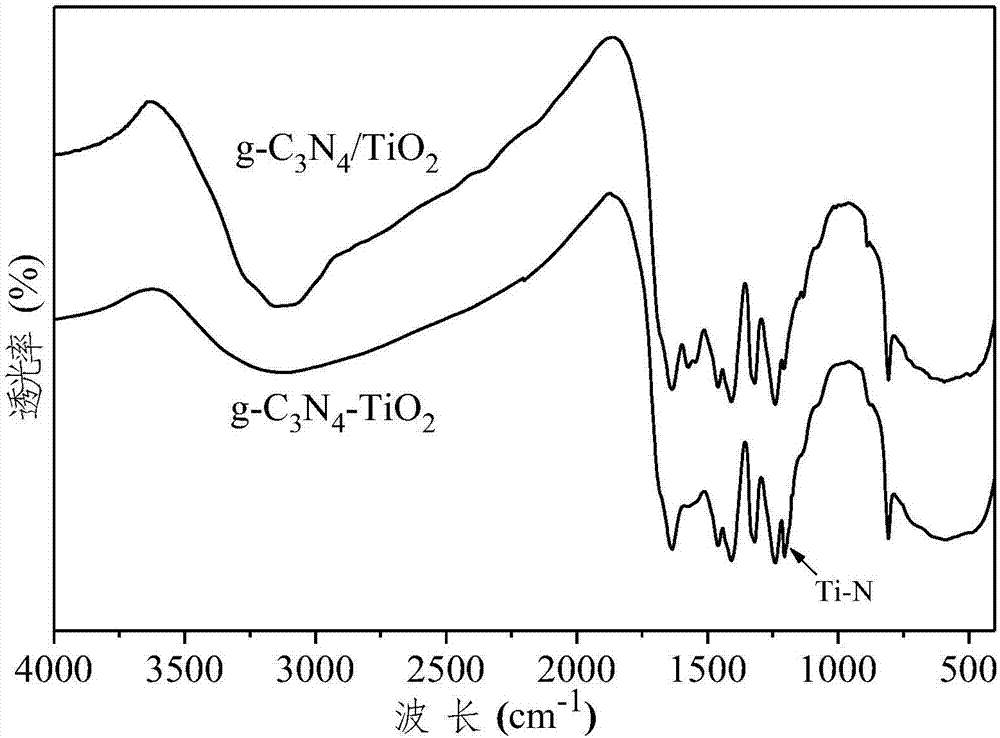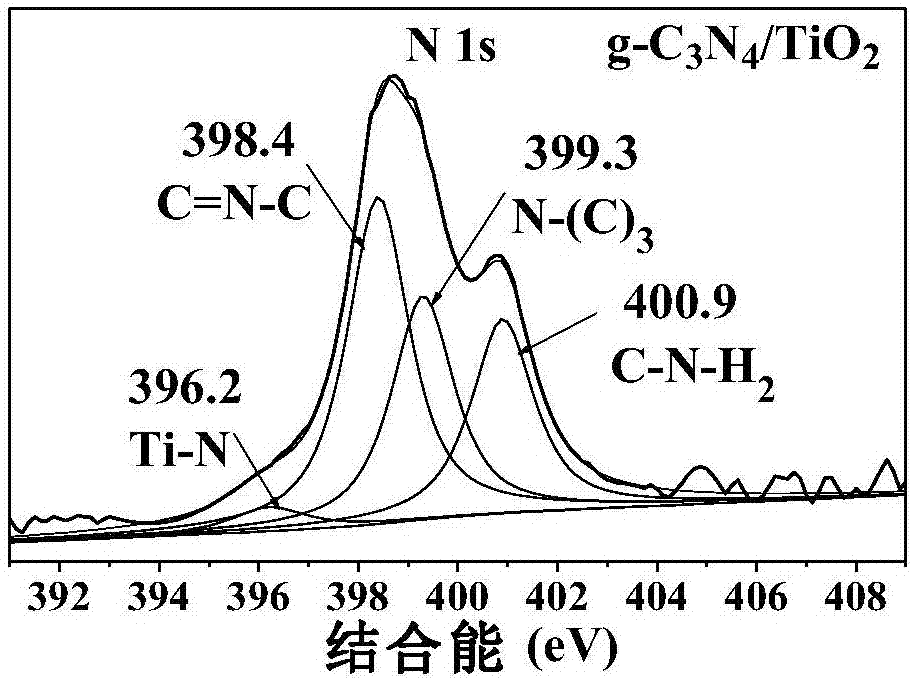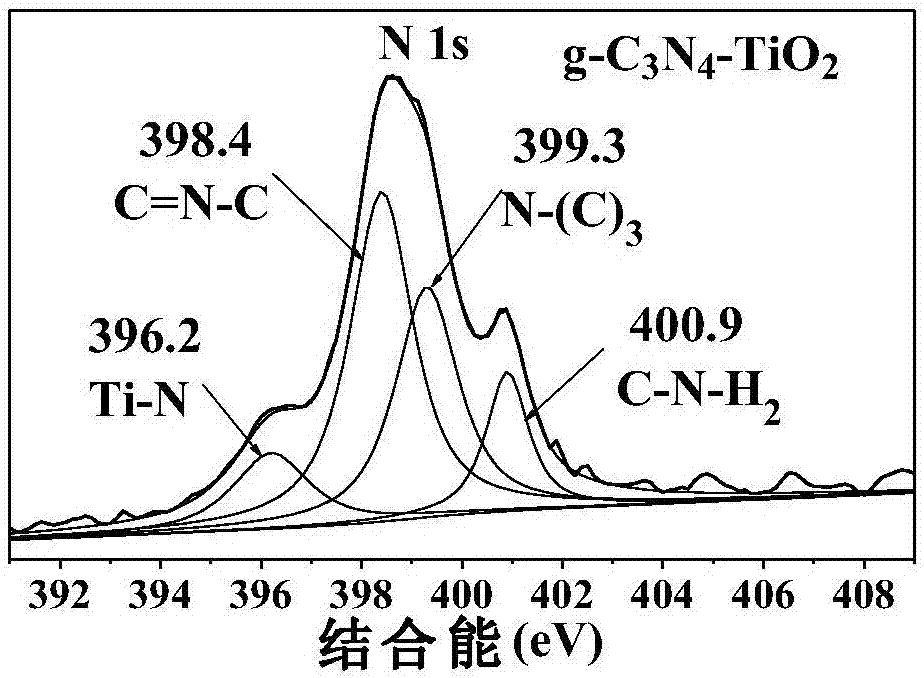G-C3N4-TiO2 heterojunction photocatalyst and preparation method thereof
A photocatalyst and heterojunction technology, applied in the field of photocatalytic materials, can solve the problems of low catalytic efficiency and photocatalytic activity, complex preparation process, harsh conditions, etc., and achieve good photocurrent response performance, simple preparation method, and mild reaction conditions. Effect
- Summary
- Abstract
- Description
- Claims
- Application Information
AI Technical Summary
Problems solved by technology
Method used
Image
Examples
Embodiment 1
[0025] Put 20g of melamine in a tube furnace and calcinate at 500°C for 4h in the air atmosphere to obtain g-C 3 N 4 .
[0026] Mix 12 mL of n-butyl titanate and 24 mL of absolute ethanol, and add 2 g of g-C prepared in the above step 3 N 4 , configured as A mixed solution; 10mL of HNO with a concentration of 1mol / L 3 Mix it with 12mL of absolute ethanol to form a mixed solution of B; add the mixed solution of B to the mixed solution of A dropwise while stirring to form a sol; transfer the sol into the reaction kettle, and carry out hydrothermal synthesis at 90°C. After 24 hours, the cooled product was filtered and separated, and the separated solid matter was washed and dried to obtain g-C 3 N 4 / TiO 2 catalyst of light.
[0027] 4g of g-C prepared in the above steps 3 N 4 / TiO 2 Add it to 150mL tetrahydrofuran, then add 1.5g dicyclohexylcarbodiimide, heat and reflux at 50°C for 5h, wash and dry the reacted product to obtain g-C 3 N 4 –TiO 2 heterojunction photocat...
Embodiment 2
[0029] Put 20g of melamine in a tube furnace and calcinate at 520°C for 4h under air atmosphere to obtain g-C 3 N 4 .
[0030] Mix 12 mL of n-butyl titanate and 24 mL of absolute ethanol, and add 3 g of g-C prepared in the above step 3 N 4 , configured as A mixed solution; 10mL of HNO with a concentration of 1mol / L 3 Mix it with 12mL of absolute ethanol to prepare B mixed solution; add B mixed solution drop by drop to A mixed solution while stirring to form a sol; After 24 hours, the cooled product was filtered and separated, and the separated solid matter was washed and dried to obtain g-C 3 N 4 / TiO 2 catalyst of light.
[0031] 4g of g-C prepared in the above steps 3 N 4 / TiO 2 Add to 150mL tetrahydrofuran, then add 2g dicyclohexylcarbodiimide, heat and reflux at 55°C for 8 hours, wash and dry the reacted product to obtain g-C 3 N 4 –TiO 2 heterojunction photocatalysts.
Embodiment 3
[0033] Put 20g of melamine in a tube furnace and calcinate at 540°C for 4h in the air atmosphere to obtain g-C 3 N 4 .
[0034] Mix 12 mL of n-butyl titanate and 24 mL of absolute ethanol, and add 4 g of g-C prepared in the above step 3 N 4 , configured as A mixed solution; 10mL of HNO with a concentration of 1mol / L 3 Mix it with 12mL of absolute ethanol to form a mixed solution of B; add the mixed solution of B to the mixed solution of A dropwise while stirring to form a sol; transfer the sol into the reaction kettle, and carry out hydrothermal synthesis at 120°C. After 24 hours, the cooled product was filtered and separated, and the separated solid matter was washed and dried to obtain g-C 3 N 4 / TiO 2 catalyst of light.
[0035] 4g of g-C prepared in the above steps 3 N 4 / TiO 2 Add to 150mL tetrahydrofuran, then add 2.5g dicyclohexylcarbodiimide, heat and reflux at 60°C for 10h, wash and dry the reacted product to obtain g-C 3 N 4 –TiO 2 heterojunction photoca...
PUM
 Login to View More
Login to View More Abstract
Description
Claims
Application Information
 Login to View More
Login to View More - R&D
- Intellectual Property
- Life Sciences
- Materials
- Tech Scout
- Unparalleled Data Quality
- Higher Quality Content
- 60% Fewer Hallucinations
Browse by: Latest US Patents, China's latest patents, Technical Efficacy Thesaurus, Application Domain, Technology Topic, Popular Technical Reports.
© 2025 PatSnap. All rights reserved.Legal|Privacy policy|Modern Slavery Act Transparency Statement|Sitemap|About US| Contact US: help@patsnap.com



